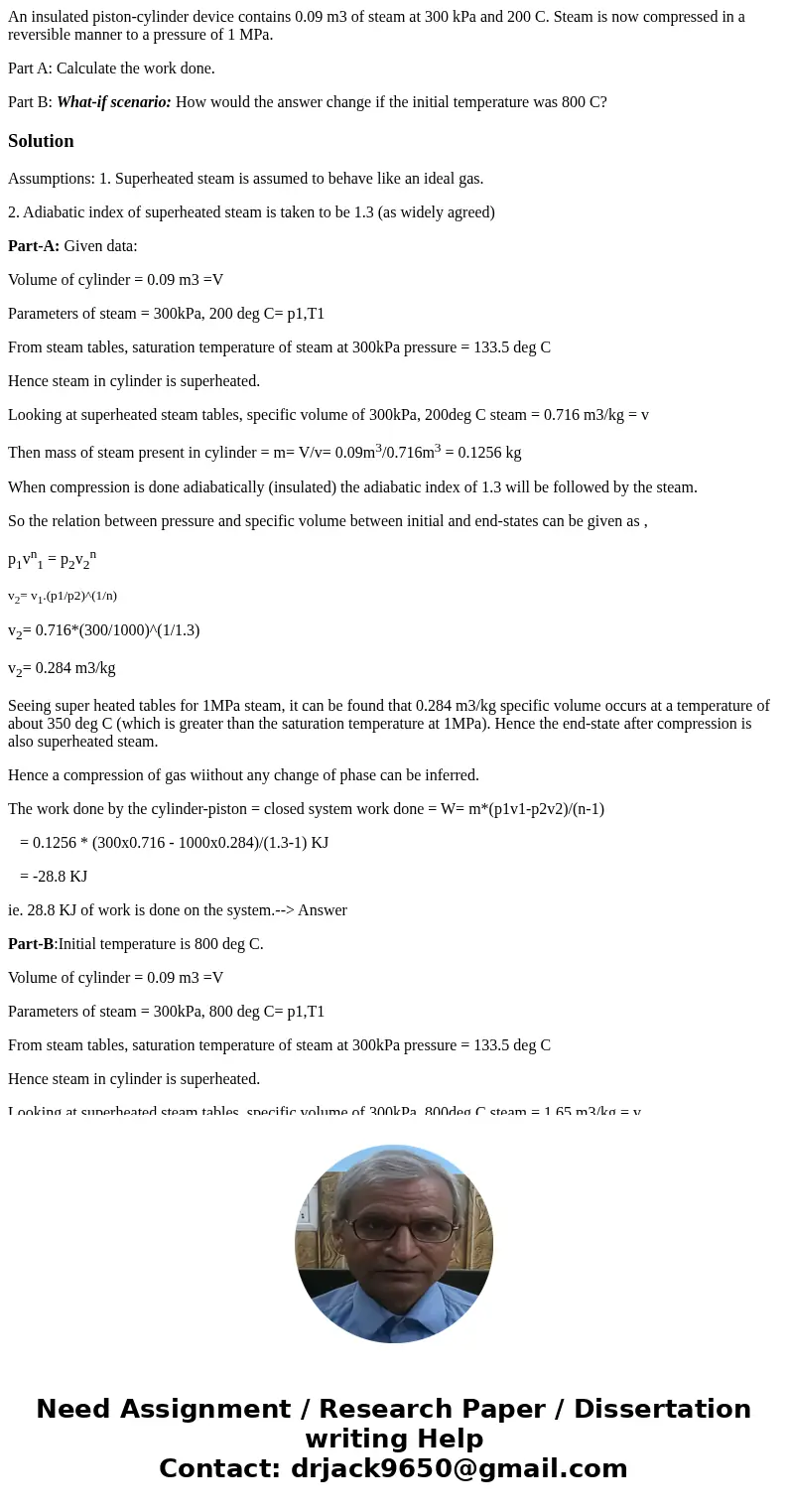An insulated pistoncylinder device contains 009 m3 of steam
An insulated piston-cylinder device contains 0.09 m3 of steam at 300 kPa and 200 C. Steam is now compressed in a reversible manner to a pressure of 1 MPa.
Part A: Calculate the work done.
Part B: What-if scenario: How would the answer change if the initial temperature was 800 C?
Solution
Assumptions: 1. Superheated steam is assumed to behave like an ideal gas.
2. Adiabatic index of superheated steam is taken to be 1.3 (as widely agreed)
Part-A: Given data:
Volume of cylinder = 0.09 m3 =V
Parameters of steam = 300kPa, 200 deg C= p1,T1
From steam tables, saturation temperature of steam at 300kPa pressure = 133.5 deg C
Hence steam in cylinder is superheated.
Looking at superheated steam tables, specific volume of 300kPa, 200deg C steam = 0.716 m3/kg = v
Then mass of steam present in cylinder = m= V/v= 0.09m3/0.716m3 = 0.1256 kg
When compression is done adiabatically (insulated) the adiabatic index of 1.3 will be followed by the steam.
So the relation between pressure and specific volume between initial and end-states can be given as ,
p1vn1 = p2v2n
v2= v1.(p1/p2)^(1/n)
v2= 0.716*(300/1000)^(1/1.3)
v2= 0.284 m3/kg
Seeing super heated tables for 1MPa steam, it can be found that 0.284 m3/kg specific volume occurs at a temperature of about 350 deg C (which is greater than the saturation temperature at 1MPa). Hence the end-state after compression is also superheated steam.
Hence a compression of gas wiithout any change of phase can be inferred.
The work done by the cylinder-piston = closed system work done = W= m*(p1v1-p2v2)/(n-1)
= 0.1256 * (300x0.716 - 1000x0.284)/(1.3-1) KJ
= -28.8 KJ
ie. 28.8 KJ of work is done on the system.--> Answer
Part-B:Initial temperature is 800 deg C.
Volume of cylinder = 0.09 m3 =V
Parameters of steam = 300kPa, 800 deg C= p1,T1
From steam tables, saturation temperature of steam at 300kPa pressure = 133.5 deg C
Hence steam in cylinder is superheated.
Looking at superheated steam tables, specific volume of 300kPa, 800deg C steam = 1.65 m3/kg = v
Then mass of steam present in cylinder = m= V/v= 0.09m3/1.62 m3 = 0.0545 kg
When compression is done adiabatically (insulated) the adiabatic index of 1.3 will be followed by the steam.
So the relation between pressure and specific volume between initial and end-states can be given as ,
p1vn1 = p2v2n
v2= v1.(p1/p2)^(1/n)
v2= 1.65*(300/1000)^(1/1.3)
v2= 0.6535 m3/kg
Seeing super heated tables for 1MPa steam, it can be found that 0.653 m3/kg specific volume occurs at a temperature of about 1150 deg C (which is greater than the saturation temperature at 1MPa). Hence the end-state after compression is also superheated steam.
Hence a compression of gas wiithout any change of phase can be inferred.
The work done by the cylinder-piston = closed system work done = W= m*(p1v1-p2v2)/(n-1)
= 0.0545 * (300x1.65 - 1000x0.6535)/(1.3-1) KJ
= -28.8 KJ
ie. 28.8 KJ of work is done on the system. --> Answer
Remark: The work done on the system in both cases is the same. It is because of the fact that closed system work on a given volume of gas (0.09m3 in this case) is same for a given pressure ratio.


 Homework Sourse
Homework Sourse